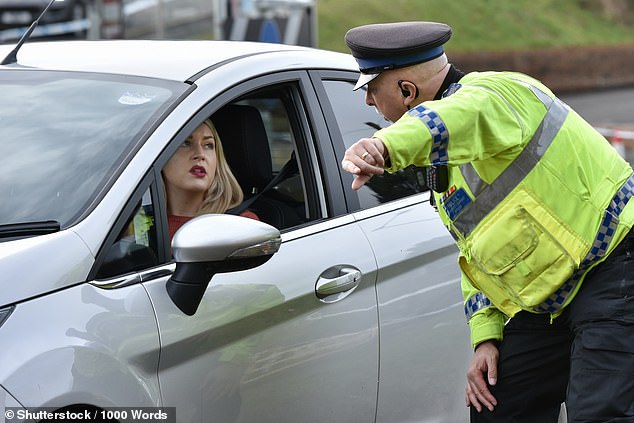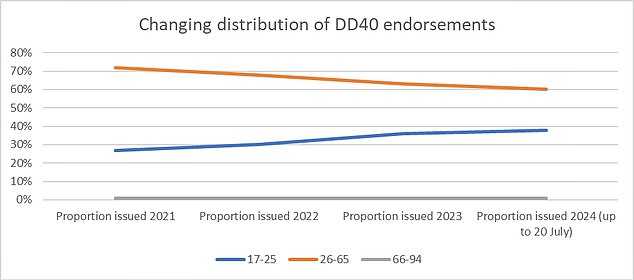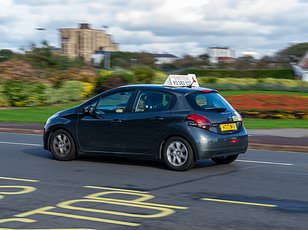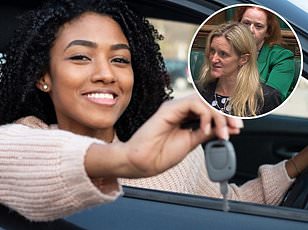Almost two in five dangerous driving endorsements issued to motorists aged 17 to 25 - so is it time for graduated licensing?
- Some 38% of DD40 enforcements are issued to the youngest drivers on the road
- Safety charities say this is yet more evidence for Britain to introduce GDL
Shocking figures show that young drivers are responsible for nearly two in five dangerous driving endorsements issued to motorists.
DVLA records show that between January and the end of May, some 1,128 new dangerous driving endorsements - known as DD40s - were issued to 17 to 25-year-olds.
This represents 38 per cent of all dangerous driving offences committed in the first five months of the year, despite this age group accounting for only 7 per cent of all full licence holders.
IAM Roadsmart, the road safety group that carried out the analysis of the government data, said the alarming figures are yet more evidence of the need for a graduated driving licensing (GDL) system in Britain to impose restrictions that would 'foster better decision making' among young, impressionable motorists.

Is it time for graduated driving licensing in Britain? Official data shows that 38% of all dangerous driving enforcements are being issued to the youngest motorists on the road
The advanced motoring group said younger drivers are becoming an increasing risk on our roads.
DVLA data shows that 27 per cent of all DD40 endorsements in 2021 were issued to 17 to 25 year olds.
In 2023, that percentage share grew to 36 per cent, and has increased again by two percentage points in the first half of 2024.
DD40 dangerous driving endorsements are issued for a variety of offences relating to someone's driving falling far below what would be expected of a competent and careful motorist, or when it would be obvious to a competent and careful driver that using a vehicle in its current state would be dangerous.
Typically, this includes behaviour such as speeding, racing or driving aggressively, ignoring traffic lights, overtaking dangerously or knowing a vehicle has a dangerous fault or unsafe load.
The fact that the youngest motorists on our roads are collecting almost two fifths of this offence type is the latest in a string of red flags around new drivers.
Road casualty statistics for Great Britain show that around a fifth of people crash within a year of passing their driving test, and nearly 5,000 people were killed or seriously injured in a crash involving a young driver in Britain in 2022.
Of these, 1,500 casualties are the young drivers themselves.
Especially worryingly is that with every extra same-age passenger, young motorists are four times more likely to crash.

This chart shows how the youngest licence holders have been accouting for an increasing percentage of dangerous driving enforcements since 2021
| AGE GROUPING | 2021 | Proportion issued | 2022 | Proportion issued | 2023 | Proportion issued | 2024 (up to 1 June) | Proportion issued |
|---|---|---|---|---|---|---|---|---|
| Under-17s | 2 | <1% | 14 | <1% | 39 | 1% | 45 | 2% |
| 17-25 | 1,585 | 27% | 1,677 | 30% | 1,928 | 36% | 1,128 | 38% |
| 26-65 | 4,130 | 72% | 3,772 | 68% | 3,378 | 63% | 1,785 | 60% |
| 66-94 | 59 | 1% | 50 | 1% | 55 | 1% | 34 | 1% |
| TOTAL | 5,776 | 5,513 | 5,400 | 2,992 |
IAM RoadSmart director of policy and standards Nicholas Lyes said: 'Something is going awry with driving standards among younger drivers when they now account for well over a third of all new dangerous driving endorsements, while at the same time making up a small proportion of overall licence holders.
'A form of graduated driver licensing should now be considered as part of an updated road safety strategy.
'We strongly believe that training, upskilling and wider experience will foster better responsibility and decision making which will make our roads safer.'
Mr Lyes added that drivers affected by GDL should benefit from reduced insurance premiums.
Both the RAC and AA have also backed the introduction of GDLs.
As part of the AA's Motoring Manifesto in April, it found that nearly three quarters of drivers (72 per cent) think a graduate licence limiting passengers is a good idea.
Responding to IAM Roadsmart's report, a DfT spokesperson said: 'The safety of our roads is an absolute priority for this Government.
'We are committed to delivering a new Road Safety Strategy - the first in over a decade.
'We will set out next steps on this in due course.'

Batley and Spen MP Kim Leadbeater has campaigned for road safety since shortly after she was elected in July 2021
Earlier this year, a Graduate Driving Licence bill was introduced in Parliament by Labour MP Kim Leadbeater.
As well as GDLs being backed by numerous safety organisations, the bill has cross-party support in the House of Commons.
This is the latest in a number of attempts made in recent years to introduce GDLs into law – most notably in 2020 by Theresa May's government - but none so far have stuck despite many parliamentary debates.
While the current bill proposal is largely based on the same stage-restrictive learning programme of previous GDL attempts, this time it's been introduced into Parliament under the 'Ten Minute Rule'.
This rule allows a backbench MP to make his or her case for a new Bill in a speech lasting up to ten minutes.
Following this, the bill passed its first reading. A date for a second reading is still to be announced.
Leadbeater has been campaigning for road safety since shortly after she was elected in July 2021.
She took up GDLs after meeting with Dr Ian Greenwood, who lost his 12-year-old daughter Alice when the car her mother was driving was hit by an 18-year-old driver.
Both the 18-year-old and his 16-year-old passenger were also killed.

A GDL would require new drivers to progress through supervisory period during their first months after passing their test. Only once they're deemed fit to drive solo would they be issued a full licence
How would a a graduate driving licensing system work?
A GDL would require all new drivers to pass through stages of experience learning and restriction – from winter weather driving to limits on the number of passengers and late night driving – where supervision is required.
As a new driver progresses through each supervisory stage, they gain more privileges until they are granted a full unrestricted driver's licence.
This would allow for new motorists to gain experience of the road gradually, with various studies finding that the first 1,000 miles covered by young motorists are most crucial in terms of safety.
New Zealand is among the countries where a similar scheme has been introduced.
Since legislation came in, there's been a 23 per cent reduction in car collision injuries for 15 to 19-year-olds, and a 12 per cent reduction for 20 to 24-year-olds in the country.
Similar schemes are used in other countries, including the US, Canada, Australia and Sweden.
































































